Accepted Scientific Name: Cycas lane-poolei C.A.Gardner
Forest. Dept. Bull. W. Australia 32: 30 1923
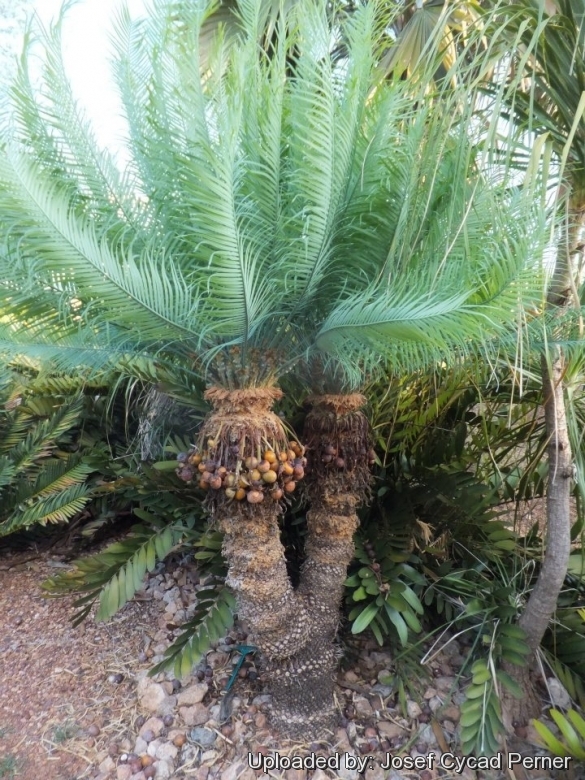
Cycas media var. lane-poolei (Cycas lane-poolei) Photo by: Josef Cycad Perner
Cycad Cones in Joe's Cycad Gardens. Cycas lane-poolii Female in seed. This is the Blueish type.
Origin and Habitat: Cycas lane-pooleiSN|31810]]SN|29956]] is known from several scattered populations in the northwest of the Kimberley region of Western Australia. Plants are found northeast of Mount Hann and near the source of the Moran River. Further, they are also found on the Mitchells Plateau and on Mount Elizabeth Station.
Altitude range: 300 to 370 metres above sea level.
Habitat and Ecology: This species occurs mostly on sandy soils in open savanna forest with Eucalyptus miniata, Eucalyptus tetrodonta or Corymbi latifolia. Intergradational populations with Cycas basalticaSN|29956]]SN|31810]] are known. Although this species has a small extent of occurrence, it occurs in remote areas with little evidence of collecting or habitat loss and the population is relatively large and stable.
Synonyms:
See all synonyms of Cycas lane-poolei
back
Accepted name in llifle Database:Cycas lane-poolei C.A.GardnerForest. Dept. Bull. W. Australia 32: 30 1923Synonymy: 3
back
Description: Cycas lane-poolei (also found as lanepoolei) is an erect palm-like cycads with a stout simple trunk up to 5 m (or more) tall; the leaves forming a craceful drooping crown at the summit. It is distinguished by the glossy green new growth and the discolorous leaflets with midrib equally prominent above and below. The leaves are very similar to those of Cycas armstrongiiSN|31800]]SN|31910]], but the plant is more robust in all respects. Cataphylls are coated with a thick wool similar to that present in Cycas canalisSN|31910]]SN|29958]] and Cycas lanata, but not seen in Cycas armstrongiiSN|29958]]SN|31910]]. Typical of all the family, the plants are dioecious and in this species, often deciduous, generally after April.
Derivation of specific name: The name intended to honours Charles Edward Lane-poole, who was Conservator of Forest in Western Australia.
Historical notes: Recognised as a distinct species by Western Australian government botanist Charles A. Gardner in 1923 on the basis of collections he made in an expedition to the Kimberley region in 1921. Later authors such as Schuster (1932) and Maconochie (19--) ignored this species or included it in a broad concept of Cycas mediaSN|31910]]SN|31800]].
Stems: Arborescent, to 5(-8) m tall, 12-15 cm in diameter at narrowest point.
Leaves: Petiolate, quite glabrous, bright green or blue (when new, aging to bright glossy green), semiglossy, 60-110 cm long, slightly keeled to flat (not keeled) in section (opposing leaflets inserted at 130-180° on rachis), with 90-170 leaflets, with white and orange tomentum shedding as leaf expands; rachis usually terminated by a spine. Petiole 18-40 cm long, glabrous, unarmed (or with few spines which are arranged alternately distally or throughout the entire length). Basal leaflets not gradually reducing to spines. Median leaflets simple entire, liner, straight and acuminate, weakly discolorous (shining dark green above, paler underneath) often with yellowish-brown tips, 60-170 mm long, 4.5-8.5 mm wide, inserted at 45-60° to rachis, the upper leaflets decurrent to the next one below for 3-5 mm, the lowest not at all, or very slightly decurrent, narrowed to 2.5-4 mm at base (to 40-70% of maximum width), 4-12 mm apart on rachis; median leaflets section flat; margins flat; apex aristate, not spinescent; midrib very conspicuous raised above, raised below.
Cataphylls: The cataphylls (Modified leaf, much reduced and thickened, serving to protect the apical meristem in cycads produced in flushes preceding the emergence of cones or leaves.) are linear, pungent, densely floccose, 60-100 mm long, persistent.
Male cones: Ovoid, orange, 10-14 cm long, 9-11 cm diam.; microsporophyll lamina firm, not dorsiventrally thickened, 25-35 mm long, 14-16 mm wide, fertile zone 22-26 mm long, sterile apex 5-10 mm long, level, apical spine prominent, sharply upturned, 8-11 mm long.
Megasporophylls: Like other Cycas species, the female plants do not bear cones; instead they carry ovules and seeds on large, feather-like megasporophylls which are 16-22 cm long, grey-tomentose and brown-tomentose; ovules 2-4, glabrous; lamina lanceolate, 40-65 mm long, 17-28 mm wide, regularly dentate, with 12-30 pungent lateral spines 1-5 mm long, 1-2 mm wide, apical spine distinct from lateral spines, 15-20 mm long.
Seeds: Flattened-ovoid, hard and glabrous 38-45(-57) mm long, 36-40(-50) mm wide; sarcotesta orange-brown, not pruinose, 3-4 mm thick; fibrous layer absent. Spongy endocarp absent. Fruiting (in habitat) in June and July.
Bibliography: Major references and further lectures
1) Whitelock, Loran M., “The Cycads”, Timber press, 2002
2) Haynes J.L, “World List of Cycads: A Historical Review,” IUCN/SSC Cycad Specialist Group, 2012.
3) C.A. Gardner, "Bull. Woods Forests Dept., Western Australia" 32: 30-32, fig. E 1923.
4) Hill, K.D. 2010. “Cycas lane-poolei”. The IUCN Red List of Threatened Species. Version 2014.3. <www.iucnredlist.org>. Downloaded on 04 January 2015.
5) The Cycad Pages “Cycas lane-poolei” Royal Botanic Gardens Sydney Written and maintained by Ken Hill 1998-2010 Maintained by Leonie Stanberg and Dennis Stevenson 2010-2012 <http://plantnet.rbgsyd.nsw.gov.au/cgi-bin/cycadpg?taxname=Cycas+lane-poolei> Downloaded on 04 January 2015.
6) Hill, K.D. & Osborne, R.O. “Cycads of Australia.” Kangaroo Press, Sydney. 2001
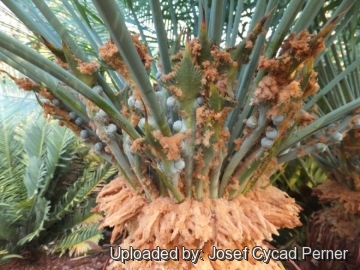 This is the Blueish type. I missed pollinating the last seed flush so the seeds won't be viable. At Cycad International. (Cycas lane-poolei) Photo by: Josef Cycad Perner
This is the Blueish type. I missed pollinating the last seed flush so the seeds won't be viable. At Cycad International. (Cycas lane-poolei) Photo by: Josef Cycad Perner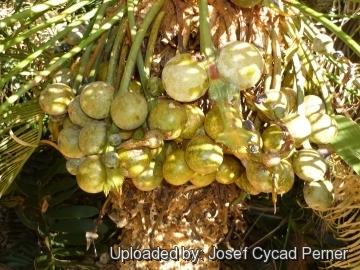 Cycad Cones in Joe's Cycad Gardens. Cycas lane-poolei seeds. (Cycas lane-poolei) Photo by: Josef Cycad Perner
Cycad Cones in Joe's Cycad Gardens. Cycas lane-poolei seeds. (Cycas lane-poolei) Photo by: Josef Cycad Perner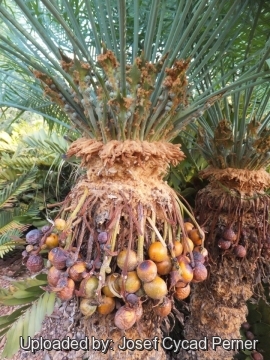 Cycad Cones in Joe's Cycad Gardens.Cycas lane-poolii. See unviable seed at the top and viable seeds below. (Cycas lane-poolei) Photo by: Josef Cycad Perner
Cycad Cones in Joe's Cycad Gardens.Cycas lane-poolii. See unviable seed at the top and viable seeds below. (Cycas lane-poolei) Photo by: Josef Cycad Perner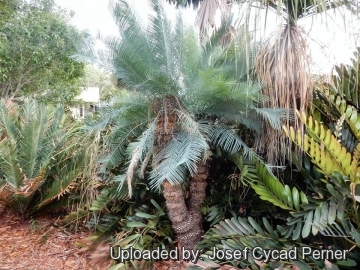 Cycas media var. lane-poolei (Cycas lane-poolei) Photo by: Josef Cycad Perner
Cycas media var. lane-poolei (Cycas lane-poolei) Photo by: Josef Cycad Perner Emerging fronds (Cycas lane-poolei) Photo by: Josef Cycad Perner
Emerging fronds (Cycas lane-poolei) Photo by: Josef Cycad Perner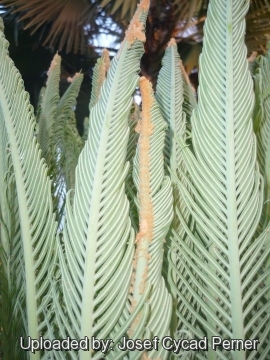 Emerging fronds. (Cycas lane-poolei) Photo by: Josef Cycad Perner
Emerging fronds. (Cycas lane-poolei) Photo by: Josef Cycad PernerCultivation and Propagation: Cycas lane-pooleiSN|29956]]SN|29956]] is suited to tropical regions which have a seasonally dry climate. It is easy to grow, tolerating dry periods.
Growth rate: Usually slow growing, however good conditions can speed it up considerably. Because of its growth habit, fertilize only when terminal bud begins to swell, indicating the start of the annual growth cycle.
Exposure: It prefers bright light exposure but colour bleaches when in full sun; best with some protection from afternoon heat.
Soil: Needs a well drained spot, with deep soil, but will still thrive in less than ideal conditions.
Maintenance: Minimal; removal of offsets if desired, removal of spent fronds.
Use: Landscape as cultivated perennial in warm, coastal areas; House-plant or interior-scape, as container plant in cool areas, as well very well suited to bonsai culture.
Propagation: Seed. After fertile seeds are collected, they usually need several months of storage before the inner embryo is ready to germinate. Therefore, it is best to clean the seeds of external fruit and set them aside before attempting to propagate the seeds.















